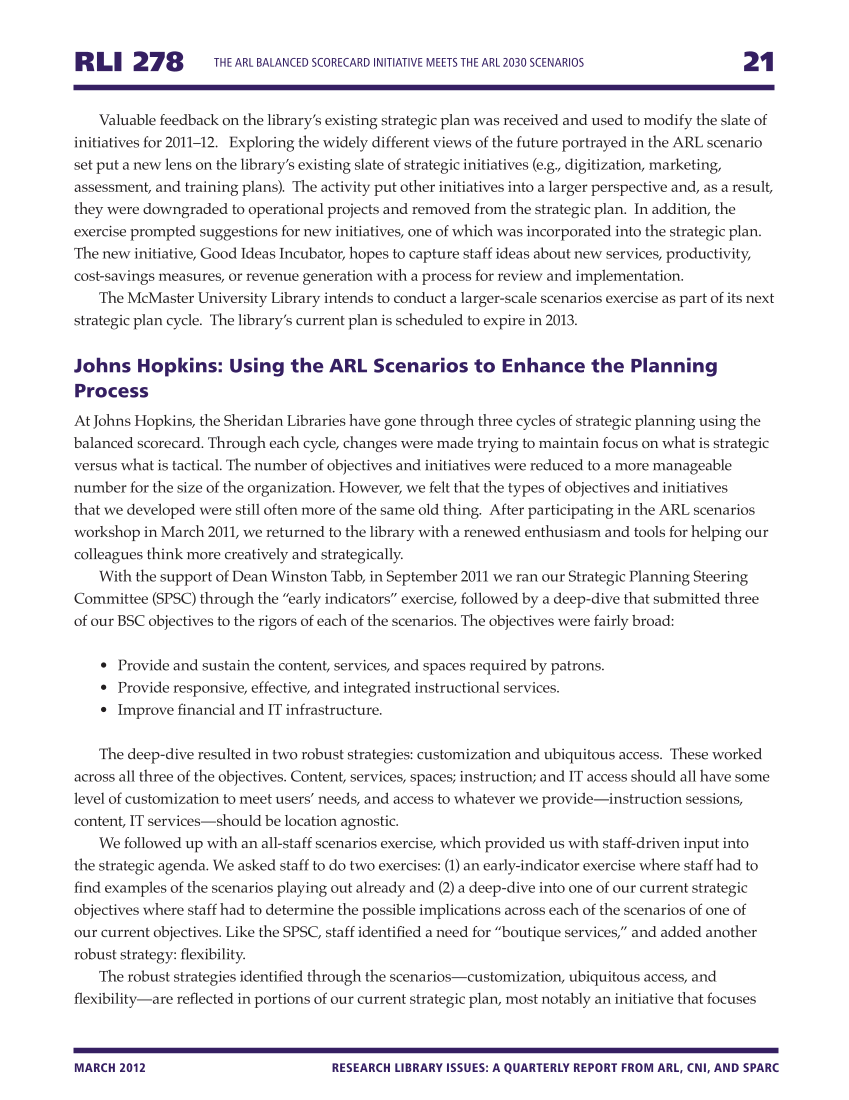March 2012R esearch Library Issues: A Quarterly Report from ARL, CNI, and SPARCarc RLI 278 21 The ARL Balanced Scorecard Initiative Meets the ARL 2030 Scenarios Valuable feedback on the library’s existing strategic plan was received and used to modify the slate of initiatives for 2011–12. Exploring the widely different views of the future portrayed in the ARL scenario set put a new lens on the library’s existing slate of strategic initiatives (e.g., digitization, marketing, assessment, and training plans). The activity put other initiatives into a larger perspective and, as a result, they were downgraded to operational projects and removed from the strategic plan. In addition, the exercise prompted suggestions for new initiatives, one of which was incorporated into the strategic plan. The new initiative, Good Ideas Incubator, hopes to capture staff ideas about new services, productivity, cost-savings measures, or revenue generation with a process for review and implementation. The McMaster University Library intends to conduct a larger-scale scenarios exercise as part of its next strategic plan cycle. The library’s current plan is scheduled to expire in 2013. Johns Hopkins: Using the ARL Scenarios to Enhance the Planning Process At Johns Hopkins, the Sheridan Libraries have gone through three cycles of strategic planning using the balanced scorecard. Through each cycle, changes were made trying to maintain focus on what is strategic versus what is tactical. The number of objectives and initiatives were reduced to a more manageable number for the size of the organization. However, we felt that the types of objectives and initiatives that we developed were still often more of the same old thing. After participating in the ARL scenarios workshop in March 2011, we returned to the library with a renewed enthusiasm and tools for helping our colleagues think more creatively and strategically. With the support of Dean Winston Tabb, in September 2011 we ran our Strategic Planning Steering Committee (SPSC) through the “early indicators” exercise, followed by a deep-dive that submitted three of our BSC objectives to the rigors of each of the scenarios. The objectives were fairly broad: • Provide and sustain the content, services, and spaces required by patrons. • Provide responsive, effective, and integrated instructional services. • Improve financial and IT infrastructure. The deep-dive resulted in two robust strategies: customization and ubiquitous access. These worked across all three of the objectives. Content, services, spaces instruction and IT access should all have some level of customization to meet users’ needs, and access to whatever we provide—instruction sessions, content, IT services—should be location agnostic. We followed up with an all-staff scenarios exercise, which provided us with staff-driven input into the strategic agenda. We asked staff to do two exercises: (1) an early-indicator exercise where staff had to find examples of the scenarios playing out already and (2) a deep-dive into one of our current strategic objectives where staff had to determine the possible implications across each of the scenarios of one of our current objectives. Like the SPSC, staff identified a need for “boutique services,” and added another robust strategy: flexibility. The robust strategies identified through the scenarios—customization, ubiquitous access, and flexibility—are reflected in portions of our current strategic plan, most notably an initiative that focuses
























